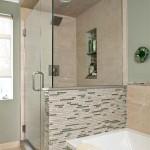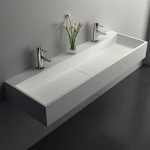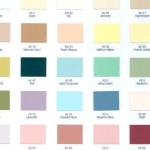What Size Rug In Front Of Bathroom Sink: A Comprehensive Guide
Selecting the appropriate size rug for the area in front of a bathroom sink is a crucial element in achieving both functional comfort and aesthetic balance within the space. A rug that is too small will appear insignificant and fail to provide adequate coverage, while a rug that is too large can overwhelm the room and potentially obstruct access to bathroom fixtures. Therefore, careful consideration of the dimensions and layout of the bathroom is essential in determining the ideal rug size.
The primary purpose of a rug in front of a bathroom sink is to provide a soft, absorbent surface for the feet after washing hands or brushing teeth. This prevents slips and falls on potentially wet or slippery tile floors and adds a layer of comfort to the often-cold surface. Beyond functionality, a rug can contribute significantly to the overall décor of the bathroom, tying together different design elements and adding a touch of style. The size of the rug must therefore strike a balance between these practical and aesthetic considerations.
Understanding standard bathroom dimensions and common rug sizes is a good starting point. However, individual bathrooms will vary significantly, requiring tailored solutions. This article will explore the key factors to consider when choosing a rug size for the area in front of a bathroom sink, providing a comprehensive guide to achieving a harmonious and functional bathroom design.
Assessing Bathroom Dimensions and Layout
The first step in determining what size rug to use in front of a bathroom sink involves a precise assessment of the bathroom's dimensions and layout. This includes measuring the length and width of the space in front of the sink, as well as the overall dimensions of the bathroom itself. Accurate measurements are essential for ensuring that the chosen rug fits proportionally within the room and does not obstruct any doorways or fixtures.
Consider the placement of the sink in relation to other bathroom elements. Is it a single vanity or a double vanity? Is the sink positioned against a wall or is it freestanding? The position of the sink significantly influences the shape and size of the rug that will work best. For example, a double vanity may require a longer rug to span the entire length, while a single vanity may only need a smaller, rectangular or even a round rug.
Beyond the immediate area around the sink, evaluate the overall flow of the bathroom. The rug should not impede traffic flow or create a tripping hazard. Ensure there is sufficient clearance around the rug for opening and closing doors, accessing the toilet, and using the shower or bath. The rug should contribute to a sense of spaciousness and ease of movement within the bathroom, not detract from it.
Take into account any architectural features that may affect rug placement, such as built-in cabinets, alcoves, or irregular wall angles. These features can limit the available space and require a more customized approach to rug selection. In some cases, a custom-made rug may be the best option to perfectly fit the unique dimensions of the bathroom.
Photographing the bathroom from different angles can also be helpful in visualizing the space and determining the optimal rug size and placement. This visual aid can help to identify potential issues and ensure that the chosen rug will complement the overall design of the bathroom.
Common Rug Sizes and Placement Guidelines
While precise measurements are essential, understanding common rug sizes and placement guidelines can provide a helpful starting point. Several standard rug sizes are commonly used in bathrooms, each suitable for different configurations and sink placements. Recognizing these sizes can expedite the rug selection process and ensure a more aesthetically pleasing outcome.
The most common rug sizes for in front of a bathroom sink include: 2x3 feet, 3x5 feet, and round rugs with diameters of 2-3 feet. A 2x3 feet rug is typically suitable for smaller bathrooms with single vanities. It provides sufficient coverage for the area directly in front of the sink without overwhelming the space. A 3x5 feet rug is a good choice for larger bathrooms with double vanities or a wider area to cover. It offers more substantial coverage and can visually connect the two sinks.
Round rugs can add a touch of softness and visual interest to a bathroom. They work especially well in front of pedestal sinks or in bathrooms with curved architectural elements. A round rug with a diameter of 2-3 feet is generally sufficient for providing comfortable footing in front of the sink.
When placing the rug, ensure that it is centered in front of the sink and extends slightly beyond the sides of the vanity. This creates a balanced and visually appealing look. Avoid placing the rug too close to the toilet or shower, as it may become frequently wet and potentially harbor bacteria. There should be a clear separation between the rug and these areas to maintain hygiene and prevent slips.
Consider the shape of the rug in relation to the shape of the vanity and the overall style of the bathroom. A rectangular rug is a classic and versatile choice that works well with most vanity shapes. However, a round or oval rug can soften the angles of a more modern or minimalist bathroom. Experiment with different shapes and placements to find the option that best complements the existing décor.
In bathrooms with limited space, a runner rug can be a practical solution. A runner placed along the length of the vanity can provide continuous coverage and visually elongate the space. However, ensure that the runner is not too long or too wide, as it may obstruct access to other bathroom fixtures.
Considering Material, Texture, and Style
Beyond size and placement, the material, texture, and style of the rug are crucial factors to consider. The rug material should be absorbent, durable, and easy to clean, as it will be exposed to moisture and frequent use. The texture of the rug should be comfortable underfoot and provide a non-slip surface. The style of the rug should complement the overall décor of the bathroom and enhance its aesthetic appeal.
Common rug materials for bathrooms include cotton, microfiber, memory foam, and synthetic blends. Cotton rugs are soft, absorbent, and relatively inexpensive. However, they may require more frequent washing and can shrink if not properly cared for. Microfiber rugs are highly absorbent, quick-drying, and resistant to stains. They are a good choice for busy bathrooms or for individuals with allergies.
Memory foam rugs offer exceptional comfort and cushioning. They are ideal for individuals who spend a lot of time standing in front of the sink. However, memory foam rugs may not be as durable as other materials and may require more gentle cleaning. Synthetic blends, such as nylon or polyester, are durable, stain-resistant, and easy to clean. They are a practical choice for high-traffic bathrooms.
The texture of the rug can significantly impact its comfort and safety. Rugs with a plush pile offer a luxurious and comfortable feel underfoot. However, they may be more difficult to clean and may not be suitable for individuals with mobility issues. Rugs with a low pile provide a more stable and non-slip surface. They are a good choice for bathrooms with children or elderly individuals.
The style of the rug should complement the overall décor of the bathroom. Consider the color scheme, patterns, and textures of the existing fixtures, tiles, and accessories. A neutral-colored rug can blend seamlessly with any style of bathroom, while a brightly colored or patterned rug can add a pop of visual interest.
In a modern bathroom, a rug with a geometric pattern or a minimalist design can create a sleek and contemporary look. In a traditional bathroom, a rug with a floral pattern or a classic border can enhance its elegant and timeless appeal. Choose a rug that reflects your personal style and complements the overall aesthetic of the bathroom.
Consider the maintenance requirements of the rug before making a purchase. Some rugs are machine washable, while others require professional cleaning. Choose a rug that is easy to care for and fits your lifestyle. Regularly vacuuming or shaking out the rug can help to remove dirt and debris and prolong its lifespan.
By carefully considering the size, placement, material, texture, and style of the rug, individuals can create a bathroom space that is both functional and aesthetically pleasing. The rug should not only provide comfort and safety but also enhance the overall design of the bathroom and reflect the homeowner's personal style.

How Should You Size Your Bathroom Rug Rugs Direct

12 Stylish Master Bathrooom Rug Decor Ideas Rugs Direct

Does My Bathroom Need A Rug Studio Mcgee

Pink And Beige Vintage Rug In Front Of Light Gray Bath Vanity Transitional Bathroom

How Should You Size Your Bathroom Rug Rugs Direct

Dark Blue Flat Front Bath Vanity With Brown Vintage Rug Transitional Bathroom

Bathroom Rugs Buy Rug Sets Bath By Ruggable

White Louvered Dual Washstand With Gold Persian Rug Transitional Bathroom

Pin On Bathroom Remodel

Kitchen Mat Faux Linen Rug Non Skid Small Area Rubber Backing Rugs For Sink Front Absorbent Bathroom Oatmeal 17 29in 47in Com
Related Posts







